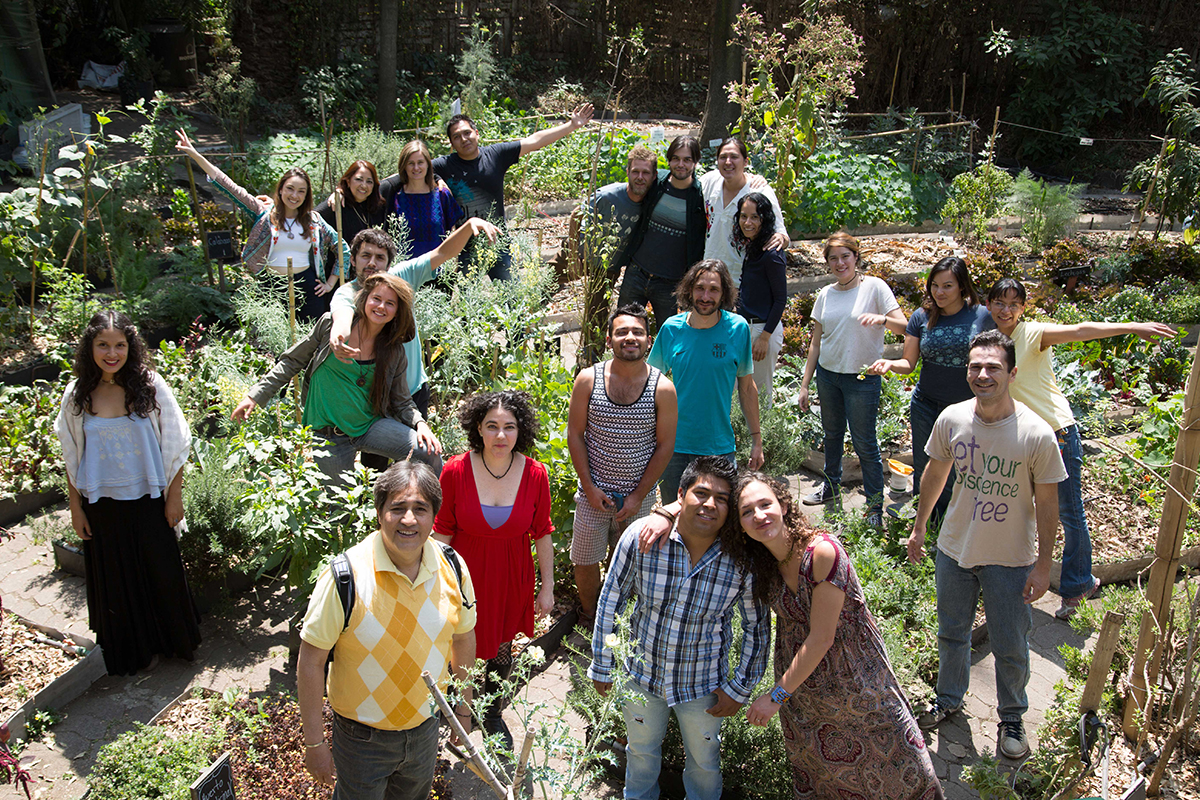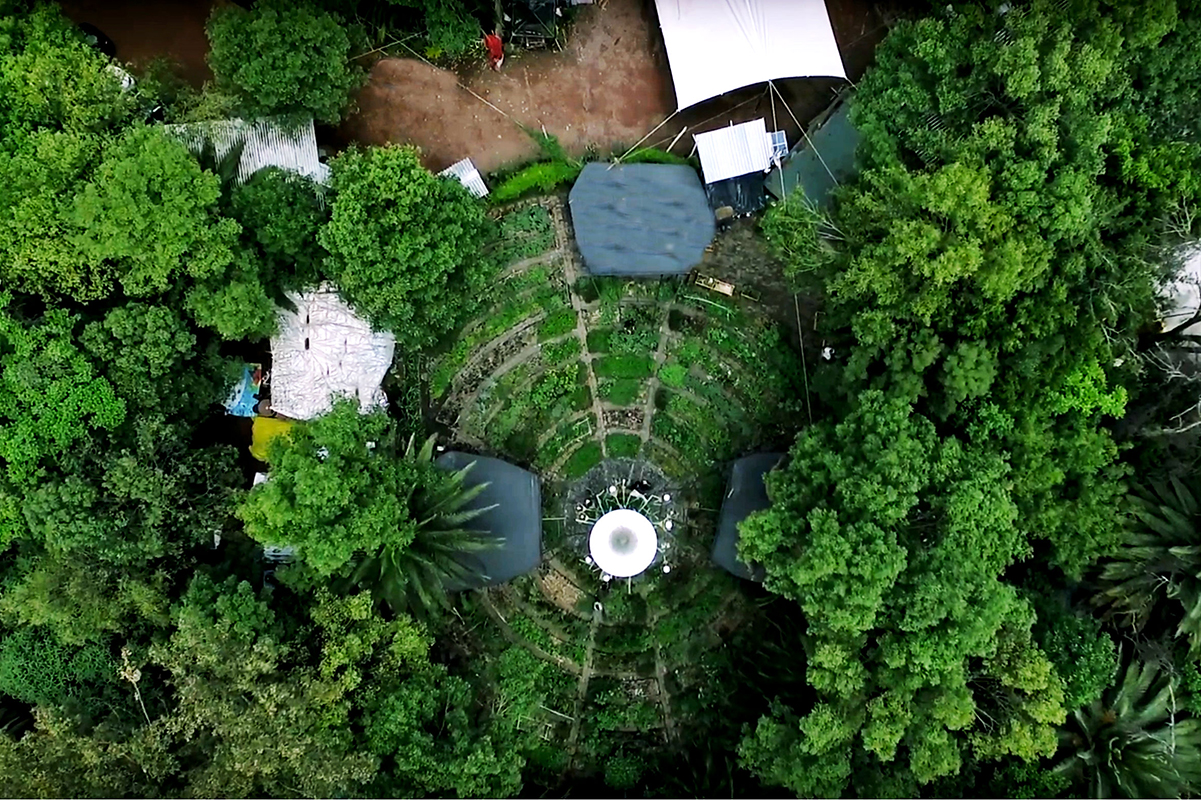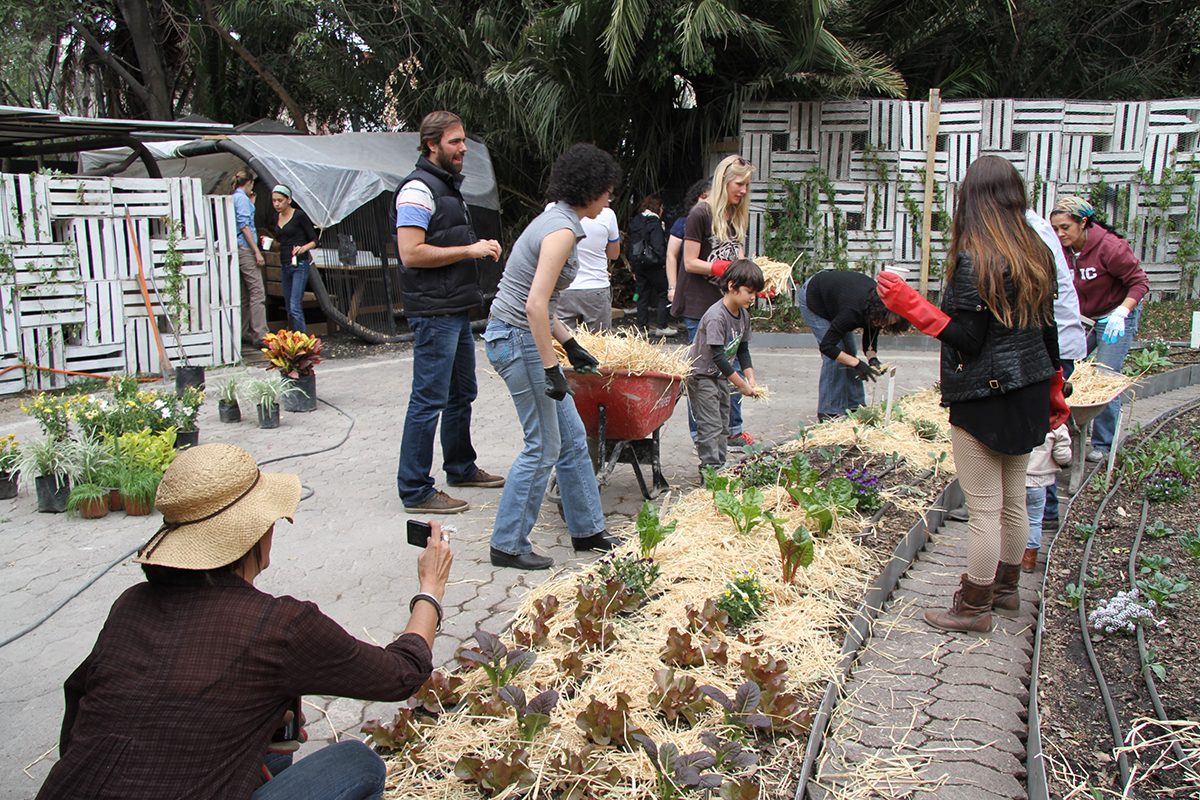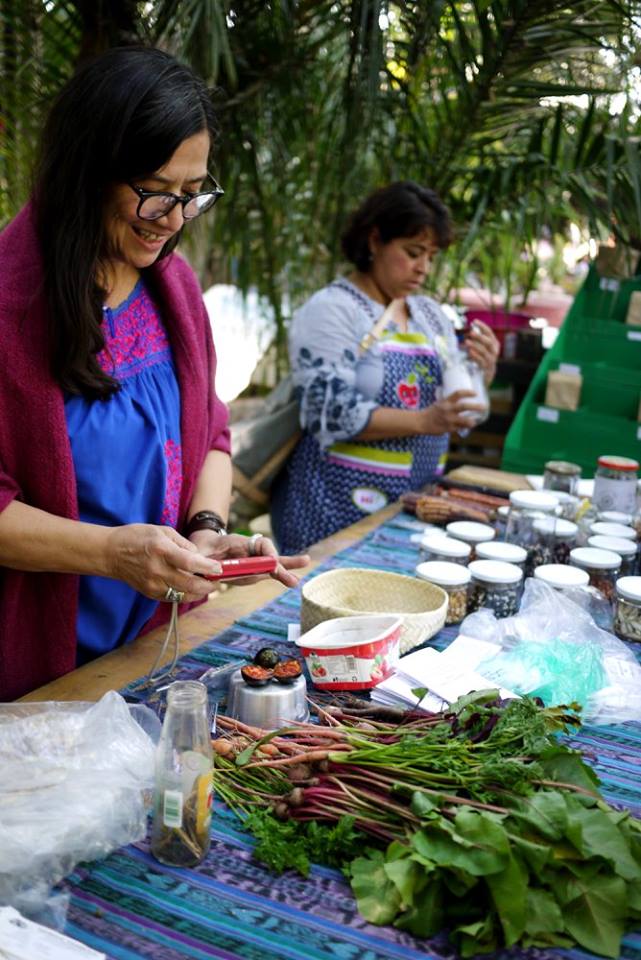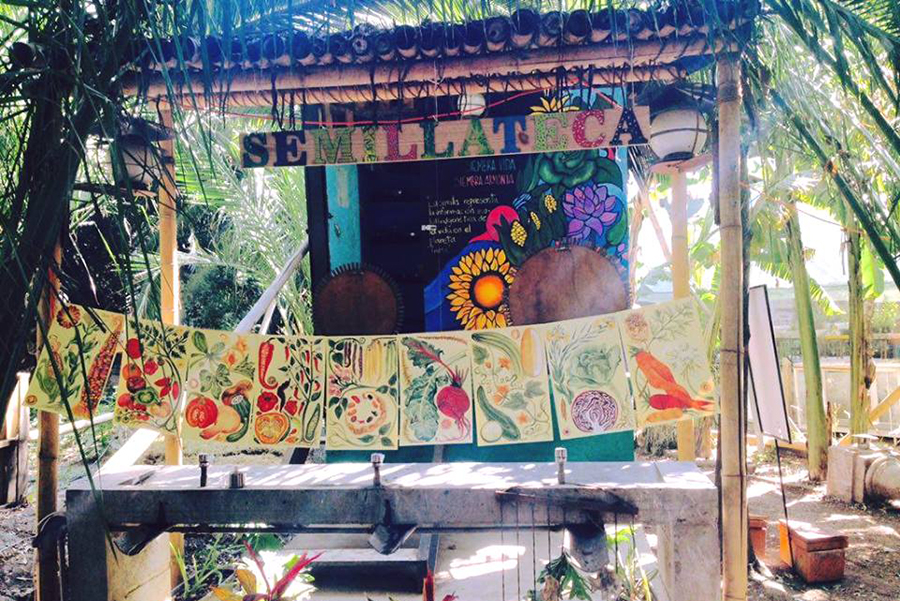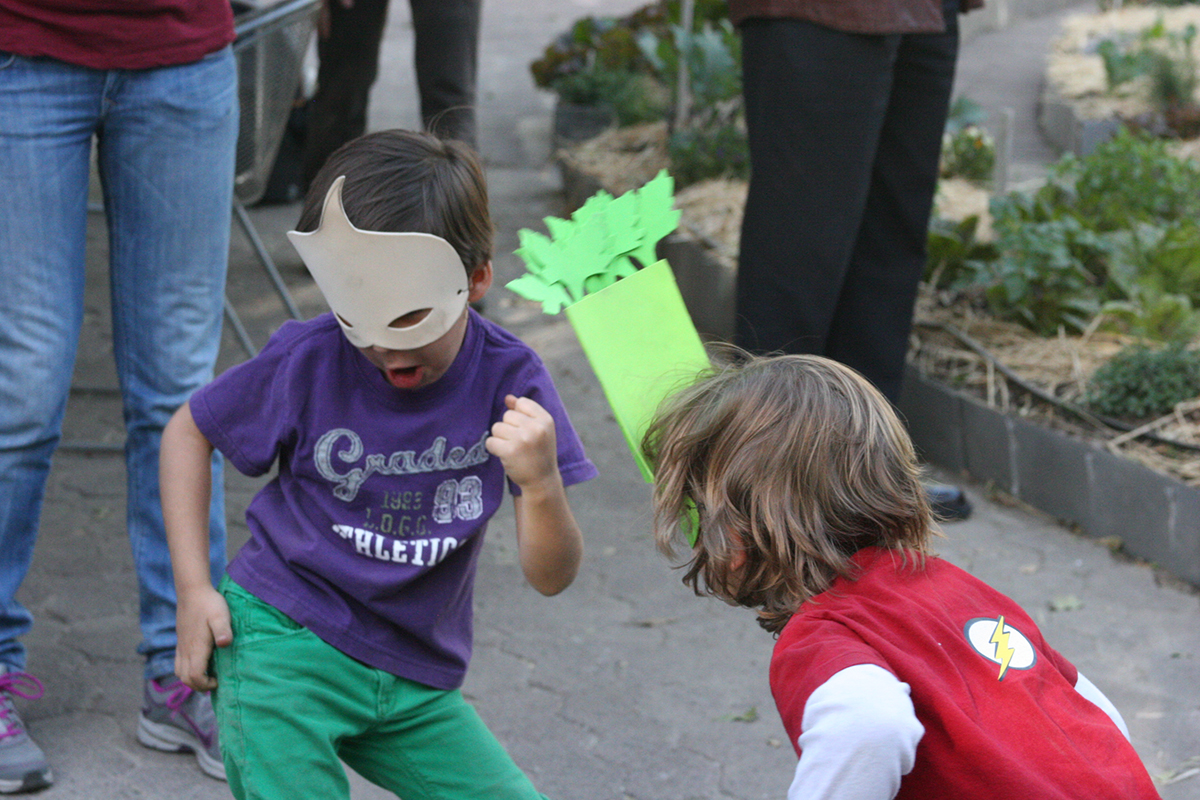Benefits of Urban Greening
Harnessing the Power of Plants
Data from Save the Soil reveals that 70% of living soils are degraded and The Food and Agriculture Organization (FAO) indicates that in 15 years there will be waves of famine if we do not modify our ways of producing and consuming food.
We need to increase living soils so that they contain the necessary minerals and microorganisms so that they can produce the food we require without the need to poison them with pesticides.
Cities must activate spaces such as HRV so that a value chain begins to be generated that starts with local compost, agroforestry on conservation soils and modifying consumption habits.
Pact with the Earth is a circular project that activates food production and responsible waste management to create consumption habits from community integration.
By promoting ResiLabs in different areas of the city, we promote this culture that not only favourably impacts the variety of edible and medicinal plants, but also plants and trees that together make up a vital ecosystem belt for general wellbeing. These regenerative spaces will create a biological corridor that also fosters the diversity of species of insects, birds and small mammals. We envision a city that integrates its rural and peri-urban areas with urban areas through ecosystem networks that combine plants, animals and human beings in a sustainable community that places land and life at the centre of priorities.
Delivering Multiple Benefits
The HRV is a space that has a great diversity of edible and medicinal plants that work in an associated way to generate an ecosystem balance that integrates techniques of syntropic agroecology and agroforestry. We have a wide variety of ornamental plants that combine with the rest of the trees, palms and shrubs that make up the HRV’s plant biodiversity, and also with the planters that are around the space.
This has increased the great diversity of insects, endemic birds and even migratory birds and mammals such as opossums and “cacomixtles” that flock to the place. We also care for caterpillars that reproduce in the space and release butterflies once they hatch from the pupa. The orchard receives bees and other pollinating insects.
The HRV is a demonstrative ResiLab of good socio-environmental practices that has had a very significant impact both in the area where it is located, and in all of Mexico City. Many similar initiatives have been inspired by what has been achieved here, at a national and international level. The space inspirated federal deputy Marcela Torres to draw up a bill for urban gardens and Dr. Victor Toledo, of great international recognition, was inspired by the HRV to propose the Citizen Centres for Sustainability. The HRV promotes what we call Civilizionary Governance Network, Towards the Regenerative BioSocial Mycelium.
The City’s Bold and Innovative Vision
HRV is more than an urban garden. It is a well known hub where the community gathers in a BioSocial Laboratory that works to face the climate emergency and allow cities to move towards sustainable, resilient and, mainly, regenerative models.
The most daring or relevant part of our process, which we call Regenerative Hikuri or Common Welfare System (SIBICO), is the comprehensive way in which we approach everything we do, in addition to doing it in Mexico City, in an area located in a strategic point within the city. It is something quite unusual, especially as we are a community squat that began work on an 8,200 m2 piece of land that was abandoned for more than 27 years, and converted it from an unhealthy and unsafe dump to a space that the UN Habitat itself pointed out as an example of urban regeneration.
The space is today recognised as a place of resistance. Thanks to the commitment and congruence of the community that supports it, it has managed to take root in the community and within more than 350 NGOs, collectives, universities and innovation companies.
We are a self-managed project that does not receive government support and that is sustained with some donations from friends and solidarity companies, but the main resources are obtained from the various activities that the garden community itself generates.
Self-management and decentralisation is the path through which we envision the future of cities that weave a possible tomorrow.
Partnerships and Collaboration
We are convinced that only through collaboration has humanity been able to achieve everything it has done. Nature is collaborative or it is not. This is what sympoiesis explains to us and this is what we promote within the HRV.
Our structure is made up of cells that individually function autopoietically but in community, they do so sympoietically.
We venture into seven axes, each of them has a coordinator who outlines their objectives and their links, and decentralises various activities to enhance the scope of their objectives. For example, the essential health area has its therapists who coordinate among themselves. However, that axis has decentralised other sub-cells such as the Temazcal and the Herbalist area. When the cells work and interact in common, transversality is produced and with it, in the centre of the Hikuri, Common Wellbeing is produced.
The HRV is also interconnected with various people, organisations and collectives that are working on socio-environmental issues, not only from the point of view of activism, but also from the academic and business spheres, so we take on the issue of linking with actors outside the space. Very seriously since this allows us to learn and expand our scope.
We also have an important relationship with various native peoples of Mexico and South America, being able to recognise that ancestral knowledge naturally vibrates with the feeling-thinking of the profound change that we require to face the climate crisis.
Addressing Urban Challenges
The Issue
If the cities do not manage to face the serious problem of demand for goods and services locally; if they are not able to reduce their water and carbon footprint; if they do not generate blue-green infrastructure; if they do not modify laws and regulations to introduce forceful actions to mitigate and adapt to the climate crisis, cities have no future. This is the gravity we face.
The Impact of the Issue
We can imagine a growing level of insecurity, violence and abandonment of social prevention, which will cause the chronic collapse of urban centres, and with it radial economic impacts that will affect millions of people, companies and institutions. The collapse is not only social but also environmental, since decay affects the ecosystemic sphere in all its aspects.
A Nature Orientated Future
It is true that one way to start acting is to place the environment as the central axis of our public policies, our citizen actions and our socio-economic undertakings. We need to make biosocial innovation a hope to make community life green again.
The ridges, gardens, parks and, of course, the ecosystem belts must be interconnected to create biological corridors capable of providing socio-environmental services that promote ResiLabs such as the HRV in each neighbourhood, neighbourhood or town of the Cities. We need to make an environmental revolution through peace centres and there the urban gardens play a crucial role by creating awareness in the community, also serving as great catalysts of hope.
Nature Positive Solutions
Implementation
HRV is an oasis within Mexico City (CDMX), a “Garden of Hope”, as Vandana Shiva described it one of the three times she has visited. It has been awarded the Flag of Peace by the International Committee of the Flag of Peace and is recognised as the house of environmentalists by the community which continually carries out activities in the space that have given rise to the signing of agreements in favour of the environment. Such as the Mexico Without Plastic Alliance https://www.youtube.com/watch?v=awyeqmEkCZI and the launch of the National Decarbonisation and Resilience Plan Mexico 2024-2030, among others.
The HRV has inspired many projects that have been carried out in other areas of the country and its influence has been such that the HRV model led the Ministry of the Environment (SEMARNAT) to consider creating Citizen Centres for Sustainability.
The HRV has been working to promote a vision of urban regeneration that seeks to replicate its method in other urban and peri-urban spaces so that in each city hall of CDMX there is at least one similar space. This not only guarantees a nucleus where edible plants and medicinal plants are cultivated to improve people’s diet, but also generates biodiverse centres for various species and, of course, healthy, interconnected, supportive communities capable of facing the climate emergency.
Feasibility
11 years of work by a community that grows and strengthens day by day is the best evidence that the project is feasible, since it bases its most important value on community action. The space has managed to become self-sufficient, because thanks to the various activities (more than 420 per year) the financial resources are obtained to pay its operating costs and to continue developing areas and strengthening spaces. We are a donee, authorised by the public treasury, which also allows us to obtain donated resources, both in kind and in cash. The HRV has obtained multiple donations in kind that have been used in the construction of new areas and in equipping others. We are activating three productive areas that will give us a greater flow of resources and help us to strengthen the project, contribute to other socio-environmental projects, hire more staff to activate other initiatives and improve the salaries of space operators. These areas are the culinary space called Floresta Cocina Regenerativa, Campo Urbano (these are already in operation) and Agroexpendio, which is a store where more than 150 small producers converge.
Undoubtedly, the work of the HRV has been considered within the initiatives that promoted the Law of Urban Gardens of the CDMX and the proposed law at the federal level, and we have been partners in the fact that it was possible to put in the political constitution of the CDMX the recognition of mother earth as a subject of law.
Multi-Stakeholder Support
HRV links with more than 300 national and international Civil Society Organisations. We have agreements with the best universities in the country and with a large number of people gathered in groups with which we work on various issues.
The Institute of Economic Research of the UNAM carried out an investigation for more than a year and a half to five social movements at the national level, HRV being one of them, which resulted in the publication of a book. We are part of Barrio Unido, Roma-Condesa neighbourhood and business association, members of Active Citizens, Mecate community of Tec de Monterrey, founders of the first Extinction Rebellion cell in Mexico, members of the Decarbonisation and Resilience Plan, signatory parties from the “Me Alianza México sin Plásticos, founders of Pacto con la Tierra and part of the Bandera de la Paz community We have obtained many recognitions, such as the National Human Rights Commission. We are part of multiple socio-environmental groups that are focused on specific issues, for example, the condemnation of the ecocides that are being carried out in various parts of the planet.
Within our space, we carry out multiple activities of citizen organisations, presentations, conferences and various plans that are focused on the issues that concern HRV. We are part of the Ríos Tarando Council to save the western ravines of CDMX.
We are a space recognised for opening its doors to initiatives that fight in favour of life and the land.
Management and Maintenance
The HRV is a self-managed space that is operated and administered by a non-profit civil association (La Cuadra A.C.) that was established in 2012 to promote socio-environmental regeneration projects. Thanks to this legal figure, we obtained the possibility of being a donee, authorised by the tax system, which allows us to access resources from various calls. This also allows us to have certificates that are important, such as CEMEFI and CAF America, which have undoubtedly opened doors for us to strengthen transparency when resources are requested. However, the most solid bet is that the HRV space, as a Social Association project, has been able to manage its resources through all the activities carried out in the space.
The community that is woven into the space is a great support and a vital component is consistency in managing the project’s objectives, making it clear that its sustainability has a component of socio-environmental responsibility that guides decision-making.
We have a project area that efficiently manages each project we undertake, both in the HRV and in actions we carry out in other spaces. We look for each cell to be self-managing and as long as that happens, there is solidarity support until it is achieved.
We have overcome the barriers by being constant and adjusting things when necessary, but always based on assertive communication.
Measuring and Reporting Impact
Monitoring Results
The HRV has a strong waste management component focused on the restoration of soils and ecosystems, associated with food security and resilient community networking.
Regarding solid waste, we have a climate action process called “Recirculate your waste”, more than 14 different recyclable waste is received https://www.pactoconlatierra.org/ The waste is used by small creative industries to transform it into utility materials.
Regarding the management of organic waste, this is done through our Earth Pact project, which is responsible for receiving organic waste free of meat matter every Wednesday. Compost is produced with this organic matter and is sold every Wednesday in “Campo Urbano”. Closing the bio circular process.
Currently, organic waste is collected from community restaurants, organic waste is taken to a space in Xochimilco, in alliance with “Nuestro Huerto”, here the composting process is carried out on a larger scale, producing living soil in a space that was eroded.
The vegetative reproduction process within the HRV begins with the harvest of seeds, which are obtained from the existing plants of our orchard called “Mandala” which has more than 30 cultivation beds. Our seeds are stored and some are sold.
We germinate the seeds in the greenhouse, then they are taken to the cultivation beds. Various medicinal plants, vegetables, etc, are harvested and all of these are sold in “Campo Urbano”.
Demonstrating Progress
The monitoring of kilos of compost, recyclable waste, cultivated varieties, harvested seeds, etc, allows us to have internal control and to be able to share the results of progress. For example, thanks to this record we can verify how the amount of waste we receive has increased and thus monitor the impact of this climate action, since this waste is incentivised upcycling, increasing the useful life of waste by transforming it into new utilitarian materials by small creative industries.
There are various parameters with which we can measure the progress of the orchard in each of the areas, so having these and monitoring them regularly allows us to set goals and objectives in the short, medium and long term, and continue to grow the projects. With these results, statistical analysis can be made to have an annual report of the results of each of the internal projects.
Based on this monitoring, we can share the results of the projects and the positive impact of each one with the public, and in this way attract more people interested in socio-environmental programs. By increasing the number of interested parties and the results, we have managed to generate agreements with various companies to continue growing the impact and generating new projects.
Measuring Impact
Social Organisation
- Average visitors per year = 200,000.
- Events of social and/or environmental impact = more than 400.
- Collaboration with environmental ventures = More than 1,000.
- Users benefited from social and educational programs = 200,000 minimum visitors.
- Seniors impacted with training activities = More than 60 activities with more than 25 people.
Environmental Integration
- Mandala
- Plants planted = More than 100,000
- Square metres agroforested or reforested = 1 hectare in Xochimilco.
Pact with the Earth
- Liters of organic waste processed into compost and vermicompost = more than 250 thousand litres.
- Users registered in the Pact with the Earth program = more than 200 families.
Animal Life
- Inhabiting species = 12 chickens and 20 cats rescued and cared for life.
Essential Health
- Herbalism
- Herbal medicine produced = more than 500 products.
Medical office
- People treated with natural or alternative medicine = more than 250 patients.
Sustainable Habitability
- Bioconstruction
- Square metres built with bioconstruction = more than 30 architectural works of bioconstruction and recycling carried out.
Appropriate technologies
- Community recycling
- Kilos of recyclable waste processed = more than 240 tons.
- Materials transformed with recycled material = 500 kg
- Rainwater harvesting
- Litres of rainwater captured, stored and reused = more than 150 thousand litres.
- Litres of water infiltrated into the water table = more than 3.5 million litres.
Urban Field
- Producers benefiting from the “Campo Urbano” agroecological market = More than 60 direct and 500 indirect consecutive years.
Resilient Culture
- Chiquiorto
- Childhoods impacted with educational activities = more than 200.
Learning and Transferability
Adaption and Enhancement
Innovating is always an exercise of continuous change, which adds knowledge from making mistakes and successes. HRV is a living example of this, which has been extremely enriching, given the diversity of learning obtained and the community richness that has developed. HRV is a laboratory for experimentation, demonstration and conjunction of projects, knowledge and initiatives that collaborate to make this space a centre for innovation in urban permaculture and knowledge of ancestral people.
The melting pot of accumulated experiences has managed to weave into the HRV a dynamic, comprehensive and systemic project that we have been collecting in manuals, documents and activities. It is important to point out that the Regenerative Hikuri is a process that has evolved over the years which we created. Through its methodology we analyse everything we do, always adding new knowledge acquired from internal and external actors.
Today, the Regenerative Hikuri is already the object of study and implementation by other initiatives that have found the proposed process very inspiring. It is used as a lens through which we can locally or globally analyse projects from a multidisciplinary and multilevel perspective.
Potential for Replication
One of the most important goals that the HRV has at this time is to establish and consolidate all the links that have been forged over the years. There are many collectives that have stated that the HRV has inspired them to promote their projects in other spaces and cities. It is also important to point out that inspired by the principle of “copyleft”, the HRV has shared the knowledge it has gained and this transfer of knowledge is inscribed in the spirit that it is urgent to provide all the knowledge obtained to whoever requests it. This represents something very special because we have also been fortunate to receive a lot of knowledge unconditionally.
We recognise ourselves with humility and great responsibility, as a space that is today an important reference in socio-environmental regeneration in urban areas of Mexico City, which we consistently sustain through our words and actions. The HRV has allowed people to get closer to the essence of seeds and medicinal plants to learn how to grow them at home, as well as plants and vegetables for family nutrition, and for this reason there is an encounter with ancestral knowledge that rescues the memory of plants and their uses, and enables a culture in favour of the fundamental value of plants and their reproduction.
Inspiring Other Cities
We were summoned by the Sustainability area of the Bank of America to compete for some land that they donated to socio-environmental projects. We were fortunate to win and we were awarded a 2.5-ht piece of land in Xochitepec, Morelos, where we have already been working on a proposal that replicates the HRV in that city.
We have also received the invitation from several cities that have indicated the HRV as a model to follow, the same in New York, Montreal, Manizales, Medellin and Bogotá, Colombia. Likewise in Bilbao, Barcelona and Madrid and in Havana, Cuba. Other interested communities have been Quito, Ecuador and Cochabamba, Bolivia, who have invited us to publicise the experience of the HRV. Within Mexico, many cities have expressed their interest in us advising on projects or helping to develop socio-environmental initiatives.
The HRV experience has been recognised by the GSEF as an example of social economy and on a personal level it fills us with great satisfaction to know that we have reached the hearts of many people who have been inspired to do bachelor’s and doctoral thesis from non-profits not only from Mexico, but from Spain and Germany. Several project documentaries have also been made and we have participated in two films: La Belle Ville (France by François Marques and Manon Turina) and El Bosque Sana (Mexico, Director Santiago Pando)
Resilience
Reducing Negative Impacts and Ensuring Sustainability
HRV directs its efforts to convert the space into an autopoiesic cell, that is, self-sustaining. As of today, we have managed to capture just over 50,000 litres of rainwater and we have calculated that to disconnect from the drinking water network we need to be able to store 80,000 more litres, which we know where and how to do. We have not discharged into the drain for eight years and we process faeces and urine through a system of biodigesters that produce biogas with which we start the community kitchen.
We process 20,000 litres of organic waste from our consumption and from a network of neighbours with whom we have the collection service. With this waste we produce compost that we use for agroforestry in Xochimilco and in HRV. Also, with the solid waste that we collect (+20 tons per month) we recycle some into toys or construction materials and furniture, and the rest we properly channel to the diverse recycling industry. We produce a wide variety of vegetables, eggs, legumes, seeds, flowers and edible herbs that are consumed by the community, and we have a study to reduce energy consumption through photovoltaic and wind panels.
We produce 25 medicines in our herbal laboratory and we have a biomaterials laboratory that works with fruit and vegetable starches. We have the most comprehensive community recycling centre in Mexico City under the umbrella of the Pact with the Earth.
Environmental Considerations
We care about demonstrating that we can work from the decentralisation of energy and water resources, which is why we have been carrying out actions aimed at achieving self-sufficiency to demonstrate that by implementing eco-techniques, generating green-blue infrastructures we can considerably reduce the water footprint and carbon.
We were pioneers in CDMX building our habitability with bamboo and bajareque techniques, also using recycled materials. Today we are about to implement a sustainable habitability project called “Crisálida” that will be placed in the HRV to demonstrate that we can make habitable spaces in a sustainable way.
A very valuable example is that the orchard area generated a microclimate that attracted many species of insects, small mammals, small reptiles and various birds. This has become an insectarium where infants can observe how butterflies are born and how biodiversity plays a fundamental role in ecosystem sustainability.
We have a bank of endemic and native seeds that we collect from our orchard and that we exchange with other spaces that preserve the identity and quality of the seeds.
We have an animal life area where rescued cats find a sanctuary of peace that is widely recognised today. We have an area for roosters and hens, many of them rescued from slaughterhouses, which inhabit a space called Chicken Itza, as it symbolizes a pyramid.
Thanks to the large amount of rain that falls in CDMX, we have projected that we can disconnect from the drinking water network.
Use of Natural Resources
From the beginning, HRV established several compost systems to begin to regenerate the soils of the space, managing to obtain living soils that we already produce today for the space as well as for other places. We established an alliance with a project in Xochimilco where we compost around 10,000 litres of organic waste per month, applying that compost in that area for agroforestry up to 10 hectares. We collect rainwater that we use for our sanitation and irrigation processes, wanting to become self-sufficient in water in the medium term. We manage biodigesters for sanitation processing, also having a wetland to improve water quality.
We seek to promote various eco-techniques that improve energy processes, which we have not been able to consolidate as we would like due to lack of resources, but this action is part of the long-term strategy.
We have solar pumps in some spaces and underground storage ponds and also in the open air, which also means that fauna finds a water supply here.
We constantly seek to acquire new technologies that help recycling and proper handling of products, for example we have a textile workshop that works with recycled and over-cycled fabrics, to have clothes that are used to work within the space or to exchange with other collectives.
We have a greenhouse to reproduce plants that are germinated and later planted in our space, and we also sell them in the store that we have called “Agroexpendio Campo Urbano”.

















